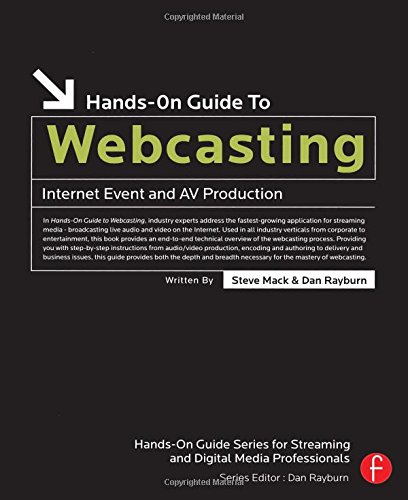Free Book Download: Hands-On Guide To Webcasting Production
 Webcasting guru Steve Mack and I wrote a webcasting production book entitled “Hands-On Guide To Webcasting” (Amazon), which we’re now giving away as a free PDF download. You might notice that the book was published in 2005 and since that time, webcasting has evolved into the mainstream application it is today. But some of the best practices regarding encoding, connectivity, and audio and video production techniques etc. have never changed. We felt the book could still be a valuable resource to many and we wanted to make it available to everyone, with webcastingbook.com now re-directing to this post.
Webcasting guru Steve Mack and I wrote a webcasting production book entitled “Hands-On Guide To Webcasting” (Amazon), which we’re now giving away as a free PDF download. You might notice that the book was published in 2005 and since that time, webcasting has evolved into the mainstream application it is today. But some of the best practices regarding encoding, connectivity, and audio and video production techniques etc. have never changed. We felt the book could still be a valuable resource to many and we wanted to make it available to everyone, with webcastingbook.com now re-directing to this post.
This book was one of the eight books in my series that combined, have sold more than 25,000 copies, with the webcasting book being the most popular. So we’re happy to have gotten the rights back to the publication to be able to share it with everyone. The help email included in the book still works, so those with questions can still reach out to us, and we’ll try to answer any follow-up questions. You may re-purpose content from the book as you like, as long as you don’t charge for it and you credit the source and link back to webcastingbook.com. Here’s a quick breakdown on the chapters
- Chapter 1 is a Quick Start, which shows you just how simple webcasting can be. If you want to start webcasting immediately, start here.
- Chapters 2 and 3 provide some background about streaming media and digital audio and video.
- Chapters 4 and 5 are focused on the business of webcasting. These chapters discuss the legal intricacies of a webcast, along with expected costs and revenues.
- Chapters 6 through 8 deal with webcast production practice. Planning, equipment, crew requirements, connectivity, and audio and video production techniques etc.
- Chapters 9 and 10 cover encoding and authoring best practices. This section also covers how to author simple metafiles and HTML pages with embedded players and how to ensure that the method you use scales properly during large events.
- Chapter 11 is concerned with distribution. This section discusses how to plan and implement a redundant server infrastructure, and how to estimate what your infrastructure needs are.
- Chapter 12 highlights a number of case studies, both successful and not so successful. These case studies provide you with some real-life examples of how webcasts are planned and executed, how they were justified, what went right, and possibly more important, what went wrong.
I’ll also be giving away my business book in the coming days.
